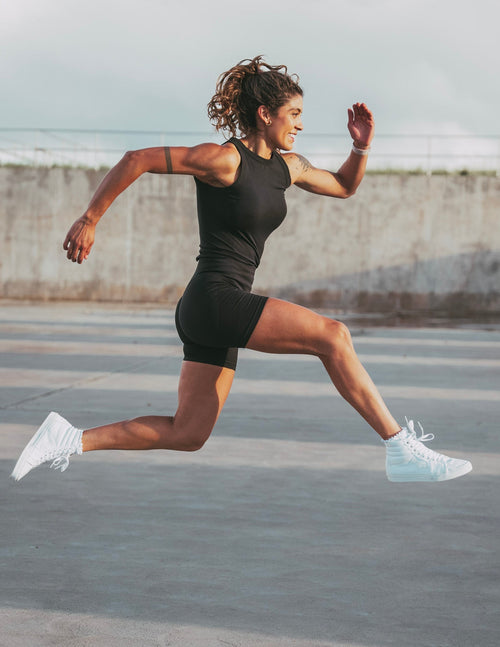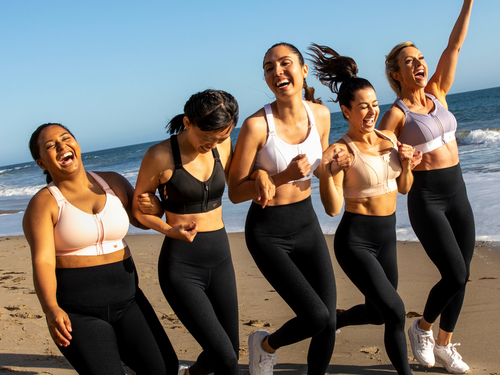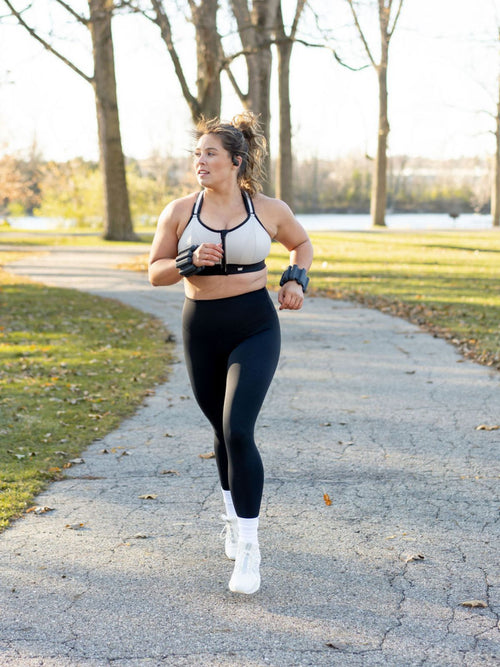15% Off Gift Cards! Shop Now
Can You Get a Full-Body Workout with Dumbbells?
There's a lot to love about dumbbells - they're simple, yet versatile. Affordable when compared to machines, and great for an at-home gym since they don't take up a lot of space. And while you most certainly know how great they are triceps, biceps, and shoulders, you might be unsure if you can get a full-body workout with dumbbells.
Yes, you can get a full-body workout with just a set of dumbbells. With the right exercises and techniques, dumbbells are an excellent way to strengthen and tone your body. For example, a workout consisting of full-body exercises in a superset format can build muscle and lose body fat.
And that's precisely what this post will walk you through. Karah, a SHEFIT Ambassador, will show you 4 supersets that prove you can get a full-body workout with dumbbells. So grab your dumbbells and throw on your Boss Leggings and Ultimate Sports Bra, because your whole body is about to witness the power of dumbbells.
4 Supersets for a Full-Body Dumbbell Workout
This full-body workout was designed by Karah and it consists of 4 supersets. Karah is something of a superset phenom - just check out her Chest HIIT Workout for proof. So you're about to learn from one of the best.
In case superset is a new term for you, it simply means performing two exercises back-to-back, with little to no rest between them. They're great for keeping your heart rate going while simultaneously working one muscle group while letting the other rest, and a perfect fit for full-body workouts.
Once you complete a superset, take a short rest, then move on to the next superset.
SUPERSET 1: 4 ROUNDS

Twisted Squat Thrusters: 10 Reps Per Side
The traditional squat thruster can be performed with dumbbells, kettlebells, or a barbell. It combines two movements, a front squat, and a shoulder press. The front squat is a regular squat with the weight held on or in front of your shoulders.
Instead of breaking them into two movements, the thruster uses the momentum from the squat to aid the shoulder press. In this variation you’ll twist as you press the dumbbell, adding a rotational component to the classic thruster.
- Step 1: Begin holding a dumbbell in your right hand with the dumbbell resting on your shoulder. Your left arm should be fully extended out to your side and held at shoulder height.
- Step 2: Place your feet shoulder-width apart, with your toes pointed outward.
- Step 3: Brace your abs, push your hips back and bend your knees, lowering the body into a squat.
- Step 4: As you stand back up to the starting position, extend your right arm above your head and rotate your torso to the left, ensuring your core is engaged.
- Step 5: Bring the weight back down to your shoulder and turn back to the starting position.
- Step 6: Repeat on the opposite side.
Muscles Targeted:
This movement starts with a squat, during which you primarily use your quadriceps, glutes, and lower back muscles. As you stand up and press, your deltoids and triceps work to lift the weight. Your core is also engaged to help you rotate. Specifically, the obliques, erector spinae, and quadratus lumborum all help with the turning motion.
Modification:
This exercise can be very taxing, so you might want to start with a bodyweight version before adding weight.
To do so, repeat the same movement without a dumbbell. Squat, then press one hand into the air and twist as you stand up. Once you’re comfortable with that movement you can try adding light weights.

Runners Lunge to Curl: 10 Reps Per Side
You don’t need to be a runner to do this movement, but it will make your workout feel much more athletic. It requires balance and stability, as well as leg strength. Even if your biceps aren’t very strong, the momentum you gain from the lunge can help you get the weights up.
- Step 1: Begin in a runner’s lunge with your right leg extended back, your left foot under your right shoulder, and holding a dumbbell in each hand with arms extended directly next to your feet.
- Step 2: Step your right foot forwards, lift upward, and drive your right knee into the air.
- Step 3: Upon extending your left knee, curl the weight while contracting your biceps.
- Step 4: Put your right foot down to return to the starting position and repeat on the opposite side.
Muscles Targeted:
As you descend into the lunge, each leg is using different muscles. The front leg uses the quadriceps, hamstrings, and inner thigh muscles to slow your descent. Then, it uses the same muscles plus the glute to propel you back up. The back leg uses the calf and quadriceps muscles to slow your descent. Then, it uses the same muscles to lift your leg, plus your hip flexors to drive your knee up. Then, you use your biceps to lift the dumbbells.
Modification:
If the balance is too difficult for this exercise, you can try a split squat with a curl at the top. Instead of stepping back and forth with your legs, you’ll step back once and hold your back foot in position. Then, pulse up and down until you’ve completed 10 reps, curling as you come up on each rep. Switch legs and repeat on the other side.
SUPERSET 2: 4 ROUNDS

Three Point Powerjacks: 10 Reps
This movement adds another level of difficulty to the jumping jack. It allows you to add weight and makes the exercise more complex. You can start with a light dumbbell, but over time, adding weight will give you an extra boost.
- Step 1: Stand with feet hip-width apart, knees soft, and toes pointed outward.
- Step 2: Hold one dumbbell with both hands in front of your hips and palms facing your thighs.
- Step 3: Keeping your spine in a neutral position and squeezing your shoulder blades together, start pushing your hips back.
- Step 4: Lower the dumbbells in front of your shins, keeping them close to your legs.
- Step 5: Once they pass your knees, don’t let your hips sink further down.
- Step 6: In a fast motion, jump your feet together and bring the dumbbell to the center of your chest for one breath, then press the dumbbell overhead with arms fully extended and jump your feet back out to hip-width apart.
- Step 7: Jump your feet back together and position the dumbbell in the center of your chest, returning to the starting position.
Muscles Targeted:
To perform the squatting and jumping motion, your legs do a lot of work. The quadriceps are mostly responsible for both motions, as well as the glutes. You also use your hip abductors and adductors to bring your feet out and in, respectively.
The lower back muscles, including the multifidus and erector spinae, help you maintain a neutral spine. Finally, the deltoids and triceps help you press the weight overhead.

Tricep Kickbacks: 10 Reps
Nearly all the movements in each superset are compound, which works multiple muscles at once and is great for burning calories. These movements are helpful for total-body strengthening but can be exhausting. This isolation exercise will help you focus on a specific area, the triceps, without added strain on your legs.
- Step 1: Hold a dumbbell in each hand with your palms facing each other, keeping your knees bent slightly.
- Step 2: Engage your core and maintain a straight spine as you hinge forward at the waist, bringing your torso almost parallel to the floor.
- Step 3: Keep your upper arms close to your body and your head in line with your spine, tucking your chin down slightly.
- Step 4: On an exhale, engage your triceps by straightening your elbows.
- Step 5: Hold your upper arms still, only moving your forearms during this movement.
- Step 6: Pause at the top of the extension, then inhale to return the weights to the starting position.
Muscles Targeted:
This movement targets the triceps, the muscles that run down the back of your arm. They’re the primary muscle used in this movement, but the rear deltoid and latissimus dorsi also contribute by keeping your arm in place as you kick the weight back.
Modification:
Instead of a kickback, you can do a lying or standing tricep extension. For a lying tricep extension, lie down on your back on a bench with your arms extended overhead. Bend your elbows and drop your hands towards your head, then extend your arms until they’re straight again.
For a standing tricep extension, hold one dumbbell with both hands. Drop the weight down behind your head, as though you’re trying to scratch your back with it. Press the weight back up until your elbows are locked out to complete one rep. You can also do this exercise from a seated position.
SUPERSET 3: 4 ROUNDS

DB Deadlift: 10 Reps
To get better at picking heavy things up from the ground, practice this exercise. While the traditional barbell deadlift is performed by lifting a weight from the floor, this variation helps you maintain proper form. It’s very important that you keep your back flat during this exercise, otherwise, you’ll put excess strain on your lower back.
- Step 1: Stand with feet hip-width apart, holding the dumbbells in front of your hips, with your palms facing your thighs.
- Step 2: Squeeze your shoulder blades together to keep your spine in a neutral position.
- Step 3: Inhale, first hinging at the hips then bending your knees to lower dumbbells down the front of your legs, pausing when your torso is parallel to the ground.
- Step 4: Exhale and drive through the mid-foot to return to standing, keeping the dumbbells close to the body throughout.
- Step 5: Fully extend your hips and knees, squeezing the glutes at the top and curling arms bringing dumbbells to shoulder level
Muscles Targeted:
The deadlift works the lower back muscles, including the erector spinae and multifidus. The hamstrings are also involved, which are the muscles that run down the back of your thigh. The glutes play a major role by extending your hips.
Strengthening your lower back can reduce or prevent lower back pain. Your lower back muscles are considered part of the “core”, so when you hear someone saying “strengthen your core,” or "keep your core tight," they’re also referring to the lower back.
Modification:
The deadlift can be performed with a kettlebell or barbell if you don’t have dumbbells. It can also be performed with one dumbbell by holding the weight vertically. Over time, this exercise should strengthen your lower back and keep you safe whenever you’re lifting heavy objects.

Rows: 10 Reps
Control is the key to mastering this back exercise. It takes discipline to stop yourself from cheating by using the weight of the body for momentum. Strengthening the upper and mid-back muscles with rows can help reduce posture-related pain and improve posture in general.
- Step 1: Hold the dumbbells so that your thumbs point towards each other and your palms face your body.
- Step 2: Stand with your feet about shoulder-width apart and knees slightly bent.
- Step 3: Slowly bend forward at your waist so that your chest is leaning forward over your feet.
- Step 4: Begin with your arms fully extended, letting the dumbbells hang at the about mid-shin level.
- Step 5: Next, lift or "row" the dumbbells up to the top and close to your stomach.
- Step 6: Slowly return to the starting position and repeat.
- Step 7: As you row, make sure to keep your head up, back straight, and your shoulders back throughout this movement so that your spine is secure and stable at all times.
Muscles Targeted:
In the row, you’ll work your back muscles. The latissimus dorsi are the biggest muscles in your back, spanning from your shoulders to your lower back. The rhomboids and trapezius lie between your shoulder blades.
The teres major and minor connect your arm and shoulder blade. You’ll also use the lower back muscles to maintain a neutral spine, and hamstrings to keep your torso in place.
Modification:
Try this movement with a kettlebell or barbell to make it more difficult. If you feel discomfort in your lower back, you can do rows with your chest supported by an elevated bench. Set your bench at an incline of about 45 degrees and lie on it, chest down, with your head above the top of the bench. Hold a weight in either hand and pull them up towards your chest.
SUPERSET 4: 4 ROUNDS

Single Arm Squat Thrusters: 10 Reps Per Side
This is similar to the first exercise in the workout, except you’ll leave the twist out. Now, you’re just going straight down and up before pressing the weight up at the top. The mix of lower and upper-body muscles puts a strain on the cardiovascular system, lifting your heart rate and making you sweat.
- Step 1: Begin holding a dumbbell in your right hand with the dumbbell resting on your right shoulder. Hold your left arm at shoulder height, fully extended out to your side.
- Step 2: Place your feet shoulder-width apart, with your toes pointing outward.
- Step 3: Brace your abs, push your hips back and bend your knees, lowering the body into a squat.
- Step 4: Upon pushing back up to the starting position extend your right arm above your head to complete the shoulder press.
- Step 5: Return the dumbbell to your shoulder to complete one rep.
Muscles Targeted:
Your leg muscles are responsible for lowering and lifting your body out of the squat. The quadriceps and glutes do the bulk of the work as far as your legs are concerned. When you press the dumbbell overhead, you use your deltoids and triceps.
Modification:
If your shoulder is tired or bothering you, try a goblet squat instead. You can do them with a kettlebell or dumbbell, and they can help you get lower into your squat while maintaining good form.
Holding the weight in front of your body helps you sit back into the squat, activating your glutes even more. To do a goblet squat, hold the dumbbell in front of your chest and squat. This movement is easier on your shoulders but still challenges the legs and core, plus it’s easier to learn.

External Rotation to Bent Lateral Raise: 5 Reps
Use light weight for this shoulder-burning exercise. The first movement strengthens the rotator cuff muscles, while the second part targets the deltoids that sit on top of the shoulders. Do enough reps of this exercise and you’ll want to put the weight down. Even if you do this without weight you should feel a burn!
- Step 1: Stand with feet shoulder-width apart, maintain a neutral spine and keep your shoulders square.
- Step 2: With a dumbbell in each hand begin with your arms bent and elbows tucked close to your body.
- Step 3: Laterally rotate your arms, keeping your elbows tucked and at a 90-degree angle until you feel a slight strain in the shoulder socket.
- Step 4: Bring the dumbbells back to the starting position.
- Step 5: Then, while maintaining the torso in a stationary position, lift the dumbbells to your side with a slight bend in the elbows and hands slightly tilted forward.
- Step 6: Continue to go up until your arms are parallel to the floor.
- Step 7: Slowly lower the dumbbells back to the starting position.
Muscles Targeted:
The first portion, the external rotation, targets three shoulder cuff muscles: the infraspinatus, supraspinatus, and teres minor. In the second half of the movement, you’ll work the deltoids, one of the large muscle groups that sit over the shoulder, and the traps to a lesser extent.
Pro Tip:
You can check your form on the external rotations by rolling up a towel and putting it between your elbows and sides. This will give you a feel for how much your elbows should press into your sides as you rotate the hands out.
When you do the lateral raises, avoid swinging the weights up by leaning backward or forwards with your upper body. The stricter the movement, the more your shoulders will work to lift the weight up.
Supersets Save the Day
It’s far too easy to extend your rest periods between exercises, particularly when you’re using very little equipment. Perhaps you gravitate back to your phone after every set or talk to your workout partner too much.
To get the most out of your dumbbell workouts, use supersets. They can tire out muscles much faster than if you had rest periods after every exercise. The exercises in this workout are challenging because most require multiple muscle groups.
Dumbbells are very maneuverable, which makes them perfect for athletic movements in this workout. It might take a few tries to master these exercises, but once you get the hang of them, you can go up in weight to increase your results.
Try the exercises if you’re bored with your current routine, or if you have a pair of dumbbells collecting dust at home. It’s hard to be bored when you’re just focusing on making it through the next set!

























